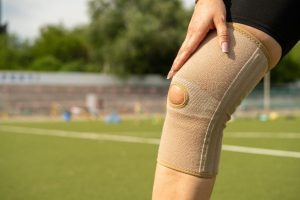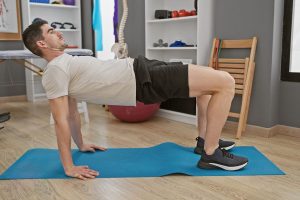As physical therapists, we are often discussing flexibility and mobility-related topics with our patients. However, what we sometimes take for granted is that our patients often don’t know the difference between flexibility vs mobility.
This is further complicated by the fact that there is a tendency of those in the health, medical, wellness, industries to interchange the terms flexibility and mobility.
The difference between flexibility and mobility is that mobility refers to a joint’s active range of motion, whereas flexibility refers to a joint’s passive range of motion. In practice, what this means is that mobility is the range of motion we are capable of moving the joint through by actively flexing the musculature involved, whereas flexibility refers to the full range of motion we are capable of achieving by allowing gravity or some other outside force to act on the joint.
We hope this article allows our readers to not just understand the difference between mobility and flexibility, but to understand:
- How flexibility feeds mobility, but they aren’t the same
- When you would choose to “work” one versus the other
- How to know when it’s time to focus on other things
Examples of Flexibility vs Mobility
Examples of flexibility drills
As mentioned above, flexibility is defined as the range of motion a muscle or joint can go through without any active input from you. Some great examples of flexibility would be:
- The single-leg runner’s hamstring stretch that we all did in gym class growing up. In this case we are using gravity or grabbing the toes and “pulling” with the arms. This “pulling” motion pulls the torso towards the thigh, elongating the relaxed hamstrings.
- A doorway stretch or “corner” stretch with one arm on each edge of the doorway or wall. In this case we are using gravity to pull us forward and stretch the pectorals.
You get the idea. In both of the examples above, the stretch itself is benefitting from the fact that the target muscle is relaxed.
Examples of mobility drills
Mobility is defined as the range of motion we can achieve through active utilization of the musculature to move that joint through space. A great example of mobility would be:
- The cat/cow exercise during which we assume a quadruped position (on all fours) and move the spine actively through flexion and extension.
- Deep squat hip rotation exercises, during which we are holding a squat position and moving the hips through various ranges of motion intentionally.
During both of the above examples, the range of motion is a result of your own musculature acting on the joint.

When would you choose to work one over the other?
If you’re a patient of ours, you shouldn’t worry about this decision. Our physical therapists will work with you on adding the appropriate flexibility and mobility training movements when your progress indicates that it’s necessary.
However, if you’re trying to work through your own process of developing the ranges of motion in specific joints in your body, here are some basic guidelines for when to choose one over the other:
Flexibility feeds mobility
The first thing we need to understand is that we’re going to have a serious uphill battle if we’re trying to develop mobility while being severely inflexible. Though we generally view mobility as more important than flexibility, that doesn’t mean we get to neglect our flexibility entirely.
While it’s true that most of the benefit of stretching is temporary (we’re increasing a joint’s range of motion by up to 10-15% for the duration of the current exercise bout), some studies also show that stretching regularly can have lasting improvements of about 6-9 degrees beyond the cessation of the current session.
The reason this matters is that if you’re trying to improve your mobility so, for example, you can continue to effortlessly pick up your children or grandchildren without fear of injury or pain, then improving our flexibility can aid us in that effort by increasing the involved joint’s passive range of motion.
Start mobility work early in the process
Since our daily lives are lived by actively using our musculature to place ourselves in the various positions we utilize, mobility is the actual thing we will need to carry out our daily tasks. This is true whether we’re discussing college athletics or an elderly person’s ability to stand up from a chair without using their arms.
Some folks have even simplified the definition of mobility into the statement: “the ability to move.”
Therefore, any of our flexibility work ought to be thought of as being for the purpose of improving our mobility, and we should begin incorporating active mobility drills into our exercise or rehabilitation practice early in the process.
When and how we do this, of course, depends on the direction of the physical therapist you’re working with.
How much mobility do we actually need?
So … how mobile do we actually need to be? At what point have we entered the realm of diminishing returns?
I’m going to give a classic “cop-out” answer here because in truth, it depends:
How flexible and mobile we need to be is very dependent on the actual activities we’ll be doing in our daily lives. It’s not hard to find examples of folks online pushing the limits of mobility, and it’s easy to think that we need to be developing extreme mobility as well.
Here’s a guideline: if you aren’t doing gymnastics, then you don’t “need” the mobility of a gymnast. You can work towards that level if you want to, you just don’t “need” to.
However, if you’re a gardener (for example), then it would behoove you to have enough mobility to comfortably hold a deep squat position without having back pain for 72 hours afterward. This is because the deep squat position is essential to the activity of gardening.
To answer the question of “how much mobility do we need”, we need to first ask ourselves: what activities are we interested in doing that we currently lack the mobility to do properly? Once we answer that question, those guiding us on our mobility journey (physical therapists, personal trainers, coaches, etc) can have a much better idea of which drills to have us do, and what we’re working on.
When to focus on other things (stability, strength, etc)
When we’re working with patients in the clinic, we try to work with them on the things that are going to move them closer to a full recovery and/or improved quality of life the most.
The reason I bring this up is because there often comes a time where a person is mobile enough, or approaching being mobile enough, that simply hammering more flexibility and mobility training isn’t going to improve their quality of life as much as focusing on other things. Additionally, strength training tends to improve mobility and flexibility on its own, regardless of other mobility work performed.
Here’s an analogy: say we have 100 “exercise pennies” to spend on physical therapy in a given week. If we spend 90 of them on mobility exercises, that doesn’t leave much left over for anything else.
Once a person is approaching a place where their mobility is sufficient to carry out the tasks of their daily life, it makes more sense for us to spend less of their time on mobility work and more of their time on developing other qualities that will help them more, such as muscular strength or stability in the legs.
This is not to say that we stop working on mobility – we simply place mobility work in maintenance mode and focus on helping the patient develop in other ways.
Final thoughts
I hope I’ve been able to shed some light on the flexibility vs mobility discussion. In truth, working with both flexibility and mobility is a good thing. It’s important to also remember that our mobility will (generally) naturally improve as we improve our strength, as well.
If we’re smart, then we’ll choose exercises to incorporate into our routines that naturally encourage good mobility, strength, and stability together.
If you’re looking for direction on how to do this, feel free to email us or get in touch. We’re open to consultation with patients on how to formulate a good exercise routine that will serve you and keep you healthy for many years to come!

















